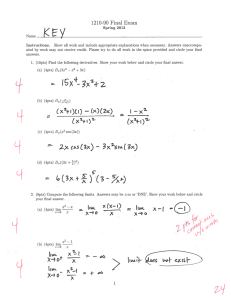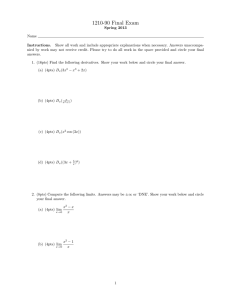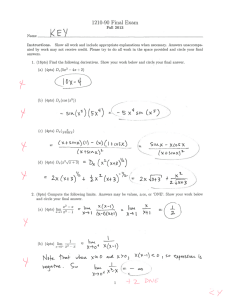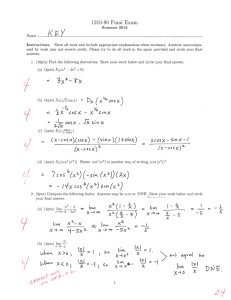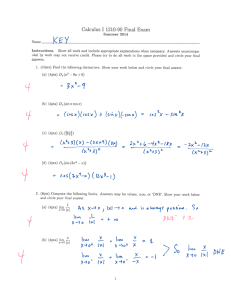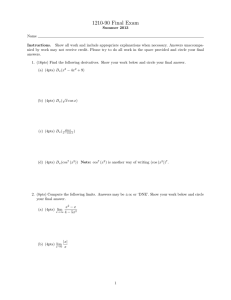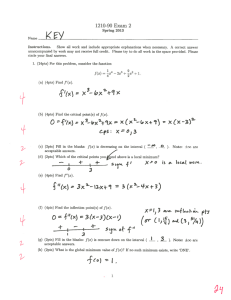I ci fI -L
advertisement
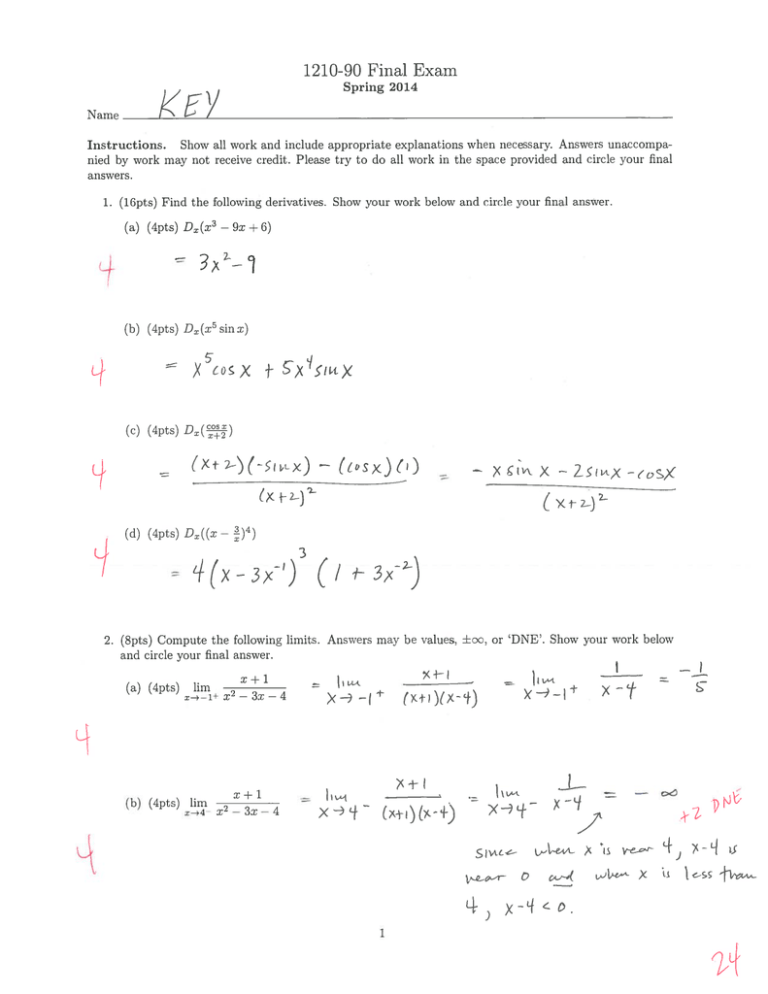
• -L T -. = 9 V It 9 - H- (C Ci) CI) = fI I 1 I C:’ > c_-i r __p — + -I • 0 C) 0 — 0 CI) D ci 0 (CC) (CC) ErD _•c z Ij 3. (8pts) Consider the function f(x) (a) (5pts) Find the equation of the tangent line to the graph of y =x 2 at the point (8 4). —) ((±) x) > (b) (3pts) Use part (a) above to estimate (8.1)2/3. 3 ()/3() 4 ( ) i) 5Lc 4. (6pts) Find the slope of the tangent line to the following curve at the point (—1, 1) 5+ xy 9(-- ‘ti& Std 2 +2 = X t-: 3 (-ii ‘ — 5. (8pts) A movie theater finds that the number of tickets it sells per show when it prices each ticket at x dollars is given by the formula N(x) = 80 lOx. Find the maximum amount of revenue the theater can earn per show. Note: revenue=cost per ticket xnumber of tickets sold= xN(x). — O—Io. - vcI 2-Dy f (4 U - - — 6O \ 2 6. (27pts) Consider the function 1 3+x 2 f’(x). (a) (4pts) Find (3tx)Co 3x - (b) (4pts) Find the critical point(s) of f. o ) (c) (2pts) Fill in the blanks: acceptable answers. f(x) is decreasing on the interval ( _Q_ (e) (4pts) Find t ). Note: ±00 are I (d) (2pts) Classify each critical point you found neither. x , iii as a local minimum, a local maximum, or part ( = f”(x). (2)( (3x (f) (4pts) Find the inflection point(s) of ()1x) ) f. O 3 3A) I’ - (g) (2pts) Fill in the blanks: acceptable answers. f(z) is concave down on the interval ( , ± ). Note: ± are (Ii) (5pts) Mean Value Theorem for Derivatives: If f is continuous on [a. b] and differentiable on (a. b), then there is at least one number c in (a, b) such that f(b) — f(a) = f’(c). Find the value of c given by the IVIean Value Theorem for Derivatives for interval [—1, 1]. - () O f(x) on the -r() ZD 27 7. (l2pts) Use both versions of the Fundamental Theorem of Calculus to evaluate the following: [2 (a) (4pts) 4 —x) dx Jo 1 [ — - I (b) (4pts) LS dt o do—need to know an antiderivative of to answer this question or (c) below. N?Y f (c) (4pts) 1 dt F ±+L c( ( / ( () -)) F 3) (3) tf 1 ) 4- 8. (l2pts) Find the following antiderivatives. Remember: i-C! (a) (4pts) (b) (4pts) f(3x2 f ± 6x + 1) dx cos (3x) dx (c(?x ) - (c) (4pts) 4 (x) cos (x) dx f5 sin toS>( Sij x 4 9uh h)ht- Jetk cv-e-r re. _2 9. (2lpts) Consider the region R iii the first quadrant bounded by y Figure A below is a rough sketch of the region R. ± 3x, the i-axis, and x = 2. (a) (5pts) Find the area of the region R. 3 = -2 1 (-+3 2. 2 —H-— 3 3 (b) (8pts) Find the volume of the solid obtained by rotating the region R around the i-axis. = ( X ) Jx_ 3 0 1 = (c) (8pts) Find the volume of the solid obtained by rotating the region R around the y-axis. V 2wj(3 2x(_ ir( - 2 3 x x , the y-axis, and p = 2 sketched in Figure 2 10. (8pts) Consider the region S bounded by the curves p = 2x of a solid obtained by rotating S around a particular axis. B below. Each integral below is the volume Match the correct axis with the expression for volume by writing the appropriate letter in the blank provided. Each answer is used exactly once. D g ((3 A f’ 7r(4 9 — — ) 2 2x — A. i-axis 1) dx B. y-axis ) dx 4 4x f 2r(x ± 1)(2 — ) dx 2 2x fir()dy C. x = —1 D. p = 3 y2 i=0 x=O x=2 1=1 Figure B Figure A 5 11. (6pts) Find the arc length of the curve y —‘i = 3 2 / between x = 1 and x = 4. f ii 3 /;_- .- Co I ‘ ( fl ‘\ Ig /2._ 12. (6pts) A .2 meter-long spring requires a force of 12 Newtons to compress it .08 meters. How much work is required to compress the spring from it natural length to a length of .1 meters? Remember: springs satisfy Hooke’s Law: F = ki, where k is the spring constant. J icm x Jo / I H / io loQJ 0 s . The 3 boloid is filled with water which has a density of 60 lbs/ft 13. (l0pts) A tank in the shape of a iisri.The radius of the tank is given by r(h) = j, where tank is 5 feet tall 5 feet wide h denotes the distance up rom t ie bottom of the tank (see the picture below). Use an integral to determine much work is required to pump the water out over the top edge of the tank. Give your answer in foot-pounds. ice 10 ktL. L+ • r2i1— W 2 c ( c (0 ) 1 q( s 11 (/z)L 6 2 () ) IE ( -
